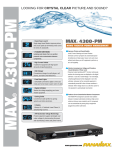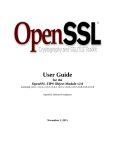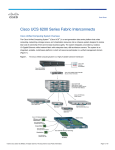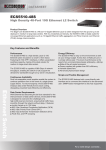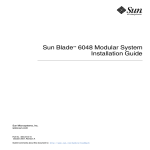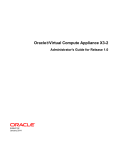Download - Oracle Documentation
Transcript
® Oracle Switch ES1-24 Release 1.3.1 Product Notes Part No.: E39113-05 October 2014 Copyright © 2013, 2014, Oracle and/or its affiliates. All rights reserved. This software and related documentation are provided under a license agreement containing restrictions on use and disclosure and are protected by intellectual property laws. Except as expressly permitted in your license agreement or allowed by law, you may not use, copy, reproduce, translate, broadcast, modify, license, transmit, distribute, exhibit, perform, publish, or display any part, in any form, or by any means. Reverse engineering, disassembly, or decompilation of this software, unless required by law for interoperability, is prohibited. The information contained herein is subject to change without notice and is not warranted to be error-free. If you find any errors, please report them to us in writing. If this is software or related software documentation that is delivered to the U.S. Government or anyone licensing it on behalf of the U.S. Government, the following notice is applicable: U.S. GOVERNMENT END USERS. Oracle programs, including any operating system, integrated software, any programs installed on the hardware, and/or documentation, delivered to U.S. Government end users are "commercial computer software" pursuant to the applicable Federal Acquisition Regulation and agency-specific supplemental regulations. As such, use, duplication, disclosure, modification, and adaptation of the programs, including any operating system, integrated software, any programs installed on the hardware, and/or documentation, shall be subject to license terms and license restrictions applicable to the programs. No other rights are granted to the U.S. Government. This software or hardware is developed for general use in a variety of information management applications. It is not developed or intended for use in any inherently dangerous applications, including applications that may create a risk of personal injury. If you use this software or hardware in dangerous applications, then you shall be responsible to take all appropriate fail-safe, backup, redundancy, and other measures to ensure its safe use. Oracle Corporation and its affiliates disclaim any liability for any damages caused by use of this software or hardware in dangerous applications. Oracle and Java are registered trademarks of Oracle and/or its affiliates. Other names may be trademarks of their respective owners. Intel and Intel Xeon are trademarks or registered trademarks of Intel Corporation. All SPARC trademarks are used under license and are trademarks or registered trademarks of SPARC International, Inc. AMD, Opteron, the AMD logo, and the AMD Opteron logo are trademarks or registered trademarks of Advanced Micro Devices. UNIX is a registered trademark of The Open Group. This software or hardware and documentation may provide access to or information on content, products, and services from third parties. Oracle Corporation and its affiliates are not responsible for and expressly disclaim all warranties of any kind with respect to third-party content, products, and services. Oracle Corporation and its affiliates will not be responsible for any loss, costs, or damages incurred due to your access to or use of third-party content, products, or services. Copyright © 2013, 2014, Oracle et/ou ses affiliés. Tous droits réservés. Ce logiciel et la documentation qui l’accompagne sont protégés par les lois sur la propriété intellectuelle. Ils sont concédés sous licence et soumis à des restrictions d’utilisation et de divulgation. Sauf disposition de votre contrat de licence ou de la loi, vous ne pouvez pas copier, reproduire, traduire, diffuser, modifier, breveter, transmettre, distribuer, exposer, exécuter, publier ou afficher le logiciel, même partiellement, sous quelque forme et par quelque procédé que ce soit. Par ailleurs, il est interdit de procéder à toute ingénierie inverse du logiciel, de le désassembler ou de le décompiler, excepté à des fins d’interopérabilité avec des logiciels tiers ou tel que prescrit par la loi. Les informations fournies dans ce document sont susceptibles de modification sans préavis. Par ailleurs, Oracle Corporation ne garantit pas qu’elles soient exemptes d’erreurs et vous invite, le cas échéant, à lui en faire part par écrit. Si ce logiciel, ou la documentation qui l’accompagne, est concédé sous licence au Gouvernement des Etats-Unis, ou à toute entité qui délivre la licence de ce logiciel ou l’utilise pour le compte du Gouvernement des Etats-Unis, la notice suivante s’applique : U.S. GOVERNMENT END USERS. Oracle programs, including any operating system, integrated software, any programs installed on the hardware, and/or documentation, delivered to U.S. Government end users are "commercial computer software" pursuant to the applicable Federal Acquisition Regulation and agency-specific supplemental regulations. As such, use, duplication, disclosure, modification, and adaptation of the programs, including any operating system, integrated software, any programs installed on the hardware, and/or documentation, shall be subject to license terms and license restrictions applicable to the programs. No other rights are granted to the U.S. Government. Ce logiciel ou matériel a été développé pour un usage général dans le cadre d’applications de gestion des informations. Ce logiciel ou matériel n’est pas conçu ni n’est destiné à être utilisé dans des applications à risque, notamment dans des applications pouvant causer des dommages corporels. Si vous utilisez ce logiciel ou matériel dans le cadre d’applications dangereuses, il est de votre responsabilité de prendre toutes les mesures de secours, de sauvegarde, de redondance et autres mesures nécessaires à son utilisation dans des conditions optimales de sécurité. Oracle Corporation et ses affiliés déclinent toute responsabilité quant aux dommages causés par l’utilisation de ce logiciel ou matériel pour ce type d’applications. Oracle et Java sont des marques déposées d’Oracle Corporation et/ou de ses affiliés.Tout autre nom mentionné peut correspondre à des marques appartenant à d’autres propriétaires qu’Oracle. Intel et Intel Xeon sont des marques ou des marques déposées d’Intel Corporation. Toutes les marques SPARC sont utilisées sous licence et sont des marques ou des marques déposées de SPARC International, Inc. AMD, Opteron, le logo AMD et le logo AMD Opteron sont des marques ou des marques déposées d’Advanced Micro Devices. UNIX est une marque déposée d’The Open Group. Ce logiciel ou matériel et la documentation qui l’accompagne peuvent fournir des informations ou des liens donnant accès à des contenus, des produits et des services émanant de tiers. Oracle Corporation et ses affiliés déclinent toute responsabilité ou garantie expresse quant aux contenus, produits ou services émanant de tiers. En aucun cas, Oracle Corporation et ses affiliés ne sauraient être tenus pour responsables des pertes subies, des coûts occasionnés ou des dommages causés par l’accès à des contenus, produits ou services tiers, ou à leur utilisation. Please Recycle Contents Using This Documentation v Oracle Switch ES1-24 Release 1.3.1 Product Notes Switch Documentation Reading Order 1 Introducing What’s New in Release 1.3 2 Logical Link Aggregation Edge Virtual Bridging IEEE DCBX 1 2 3 3 In-Band Management Reflective Relay Port Mirroring 3 3 4 Updates to 1.3 Release From Patch Update 1.3.1.7 Upgrading the Oracle Switch ES1-24 Firmware 4 4 ▼ Back Up the Current Configuration Before Upgrading ▼ Download the Switch Firmware Package ▼ Upgrade the Switch Firmware 6 7 ▼ Configure 1 Gbps Mode on SFP+ Interfaces ▼ Configure Advertised Speed on the 10GBASE-T Interfaces ▼ Fine Tune the VLAN Setup 9 10 11 Configuring In-Band Management 15 Requirements for Configuring In-Band Management ▼ 5 Configure In-Band Management for the Switch 15 16 iii Managing SEFOS Configurations 17 ▼ Include the SEFOS Configuration in Backups ▼ Restore the Configuration Configuring TACACS+ TACACS+ Properties ▼ 18 19 19 Configure TACACS+ Settings 20 Issues Corrected in the 1.3.1.7 Patch Update Issues Corrected in Prior Updates Known Issues 17 21 22 23 Switch Might Get Stuck at uboot on SSD Related Error (16922931) 24 Loss of Access to Management Node Oracle ILOM When Starting or Resetting the System (16893765) 24 CPU Hang on Power Up (16822073) 24 slb_lla: Long Time to Report Correct Status When the Link Is Down or Up (16424341) 25 SSL V3.0 POODLE DISABLE SSL V3 (19842504) 25 Re-configure IP address after a "no ip address", previous config re-appears (18794861) 26 iv Oracle Switch ES1-24 Release 1.3.1 Product Notes • October 2014 Using This Documentation This document contains late-breaking information about this release of Oracle’s Switch ES1-24. This document is written for technicians, system administrators, authorized service providers, and users who have advanced experience troubleshooting and replacing hardware. ■ “Related Documentation” on page v ■ “Feedback” on page vi ■ “Access to Oracle Support” on page vi Related Documentation Documentation Links All Oracle products http://www.oracle.com/documentation Oracle Switch ES1-24 documentation set http://docs.oracle.com/cd/E39109_01/index.html Sun Network 10GbE Switch 72p documentation set http://docs.oracle.com/cd/E19934-01/index.html Sun Blade 6000 Ethernet Switched NEM 24p 10GbE documentation set http://docs.oracle.com/cd/E19285-01/index.html v Feedback Provide feedback about this documentation at: http://www.oracle.com/goto/docfeedback Access to Oracle Support Oracle customers have access to electronic support through My Oracle Support. For information visit http://www.oracle.com/pls/topic/lookup?ctx=acc&id= info or visit http://www.oracle.com/pls/topic/lookup?ctx=acc&id=trs if you are hearing impaired. vi Oracle Switch ES1-24 Release 1.3.1 Product Notes • October 2014 Oracle Switch ES1-24 Release 1.3.1 Product Notes Review the latest information and upgrade the switch firmware to the latest version. ■ “Switch Documentation Reading Order” on page 1 ■ “Introducing What’s New in Release 1.3” on page 2 ■ “Updates to 1.3 Release From Patch Update 1.3.1.7” on page 4 ■ “Upgrading the Oracle Switch ES1-24 Firmware” on page 4 ■ “Configure 1 Gbps Mode on SFP+ Interfaces” on page 9 ■ “Configure Advertised Speed on the 10GBASE-T Interfaces” on page 10 ■ “Fine Tune the VLAN Setup” on page 11 ■ “Configuring In-Band Management” on page 15 ■ “Managing SEFOS Configurations” on page 17 ■ “Configuring TACACS+” on page 19 ■ “Issues Corrected in the 1.3.1.7 Patch Update” on page 21 ■ “Issues Corrected in Prior Updates” on page 22 ■ “Known Issues” on page 23 Switch Documentation Reading Order All of the switch product documentation and related documentation can be found at: http://docs.oracle.com/cd/E39109_01/index.html Read the documentation in this order. 1 Step Document Title or Type Information Provided 1. Oracle Switch ES1-24 Release 1.3.1 Product Notes Late-breaking information, supported configurations, and system limitations. 2. Oracle Switch ES1-24 Installation Guide Installation instructions. 3. Oracle Switch ES1-24 Configuration Guide Software configuration instructions. 4. Oracle Switch ES1-24 Service Manual Removal and installation of replaceable parts. 5. Administration Guides Reference and administration information for the software. 6. Sun Ethernet Fabric Operating System CLI Base Reference Manual CLI Base Reference Manual Base command descriptions, examples, and reference information. 7. Sun Ethernet Fabric Operating System CLI Enterprise Reference Manual CLI Base Reference Manual Enterprise command descriptions, examples, and reference information. Introducing What’s New in Release 1.3 These new features are supported for this release: ■ “Logical Link Aggregation” on page 2 ■ “Edge Virtual Bridging” on page 3 ■ “IEEE DCBX” on page 3 ■ “In-Band Management” on page 3 ■ “Reflective Relay” on page 3 ■ “Port Mirroring” on page 4 Logical Link Aggregation Logical Link Aggregation (LLA) is a layer 2 feature providing the aggregation of links from a server connected to two physical switches resulting in increased redundancy and capacity. LLA is only supported when the switch is running a Layer 2 configuration. LLA is not supported in Layer 3 configurations. Refer to the Sun Ethernet Fabric Operating System LLA Administration Guide for more information. 2 Oracle Switch ES1-24 Release 1.3.1 Product Notes • October 2014 Edge Virtual Bridging Edge Virtual Bridging enables the coordination of configuration and management of a virtualized networking environment between an end station running Oracle Solaris and the external SEFOS bridge. Refer to the Sun Ethernet Fabric Operating System EVB Administration Guide for more information. IEEE DCBX Data center bridging (DCB) Ethernet enhancements are available to improve Ethernet networking and management in data center environments. DCB is a framework that defines the enhancements that are required for switches and endpoints. DCB includes the following features: ■ PG, also known as ETS, which is a priority grouping specification that provides bandwidth management as well as a scheduling algorithm for various traffic classes on a converged link. ■ PFC, which is an enhancement to the existing Ethernet-pause protocol, that enables 0-drop packet delivery for certain traffic classes. This release of the SEFOS DCB feature supports DCB version 1.0.1 and IEEE DCBX as specified by the DCB task group. Refer to the Sun Ethernet Fabric Operating System IEEE DCBX Administration Guide for more information. In-Band Management In-band configuration mode on the switch enables access to the switch’s Oracle ILOM interface from one of the 24 10 GbE in-band ports. See “Configuring In-Band Management” on page 15. Reflective Relay Reflective relay enables the packet from a device to be returned back from the same downstream port that delivered the packets. The most common use case is when the same interface is used to transmit and receive packets. This usage can be seen while using Virtual Ethernet Packet Aggregation (VEPA). Oracle Switch ES1-24 Release 1.3.1 Product Notes 3 Refer to the Sun Ethernet Fabric Operating System CLI Base Reference Manual for more information. Port Mirroring Port mirroring enables forwarding a copy of a packet received on one interface (source) to another interface (destination) on the same switch. Refer to the Sun Ethernet Fabric Operating System Port Mirroring Administration Guide for more information. Updates to 1.3 Release From Patch Update 1.3.1.7 ■ Upink Port Trailing Feature monitors the state of the uplink port and manages the downlink ports according to the state of the uplink port. When the uplink goes down, the downlink port(s) will be shut down, providing the HA feature the feedback it needs to switch over to alternate link or path. For more details, refer to the Uplink Trailing Administration Guide. ■ VRRPv3 (VRRP version 3) extends capability to IPv6 in addition to IPv4. Version 3 supports sub-second operation. It also supports accept-mode configuration. For more details, refer to the VRRPv3 Administration Guide. ■ Change Request (CR) fixes. See “Issues Corrected in the 1.3.1.7 Patch Update” on page 21. Upgrading the Oracle Switch ES1-24 Firmware The Oracle_Switch_ES1-24_sefos-1_3_1_7.pkg restores the switching software and required components to version 1.3.1.7. 4 ■ “Back Up the Current Configuration Before Upgrading” on page 5 ■ “Download the Switch Firmware Package” on page 6 ■ “Upgrade the Switch Firmware” on page 7 Oracle Switch ES1-24 Release 1.3.1 Product Notes • October 2014 ▼ Back Up the Current Configuration Before Upgrading Save the current configuration to a remote site before upgrading the software. Refer to the Oracle Switch ES1-24 Configuration Guide for additional information. You can also use the backup and restore feature from Oracle ILOM to save the current Oracle ILOM and SEFOS configurations to a remote server. You can then restore the switch configuration after upgrading the firmware. See “Include the SEFOS Configuration in Backups” on page 17. Note – During the upgrade, if you answer yes to the question Preserve existing configuration (y/n)?, the Oracle ILOM and SEFOS configurations are automatically preserved. There is no need to explicitly restore the configuration. 1. Configure the default IP address. a. Enter Global Configuration mode. SEFOS# configure terminal b. Configure the default IP address and subnet mask as 10.0.0.100 and 255.255.0.0. SEFOS(config)# default ip address 10.0.0.100 subnet-mask 255.255.0.0 c. Exit Global Configuration mode. SEFOS(config)# end 2. Configure the restoration file name. a. Enter Global Configuration mode. SEFOS# configure terminal b. Configure a configuration restoration file name. SEFOS(config)# default restore-file myconfig.conf Oracle Switch ES1-24 Release 1.3.1 Product Notes 5 c. Exit Global Configuration mode. SEFOS(config)# end 3. Save the current configuration for restoration. SEFOS(config)# write startup-config 4. Copy the configuration file to a remote location. SEFOS(config)# copy startup-config tftp://12.0.0.100/switch.conf 5. Exit and restart the switch. SEFOS# exit -> reset /SP Are you sure you want to reset /SP (y/n)? y Performing reset on /SP 6. Log in and save the current configuration again before starting the upgrade. SEFOS# write startup-config SEFOS# copy startup-config tftp://12.0.0.100/switch.conf 7. Download the switch firmware package. See “Download the Switch Firmware Package” on page 6. ▼ Download the Switch Firmware Package After backing up your current configuration, download the switch firmware upgrade package Oracle_Switch_ES1-24_sefos-1_3_1_7.pkg. 1. Log in to My Oracle Support at: http://support.oracle.com 2. Select the Patches & Updates tab. 3. Under the Patch Search section, select Product or Family (Advanced Search). 4. Type switch in the Product field and select Oracle Switch ES1-24. 5. Select the down arrow in the Release field and select the Oracle Switch ES1-24 folder. 6 Oracle Switch ES1-24 Release 1.3.1 Product Notes • October 2014 6. Select the 1.3 release. 7. Click the Search button. 8. Click the number in the Patch Name column. 9. Click Download. 10. Click the filename of the .zip file to begin the download. 11. Save the file to an appropriate location. 12. Upgrade the firmware. See “Upgrade the Switch Firmware” on page 7. ▼ Upgrade the Switch Firmware Note – You must be logged in as root to perform the upgrade. Note – Before upgrading the switch firmware, back up the current configuration as described in “Back Up the Current Configuration Before Upgrading” on page 5. 1. Ensure that you have a network configuration in place on the switch. For more information, refer to the Oracle Switch ES1-24 Installation Guide. 2. Use TFTP, FTP, or the Oracle ILOM web interface to copy the firmware image to your server. The firmware image file is Oracle_Switch_ES1-24_sefos-1_3_1_7.pkg. 3. Answer the questions that appear on the screen as you proceed through the installation. The following example illustrates the upgrade process using FTP from a server with an IP address of 192.168.1.100. -> cd /SP/firmware/ /SP/firmware -> load -source ftp://username:[email protected]/Oracle_Switch_ES1-24_sefos1_3_1_7.pkg Downloading firmware image. This will take several minutes. . Oracle Switch ES1-24 Release 1.3.1 Product Notes 7 NOTE: An upgrade takes several minutes to complete. ILOM will enter a special mode to load new firmware. No other tasks can be performed in ILOM until the firmware upgrade is complete and ILOM is reset. Are you sure you want to load the specified file (y/n)? y Preserve existing configuration (y/n)? y Starting FW upgrade. This will take approximately 3 minutes. Checking "root file system image" Starting Root File System upgrade Upgrading Root File System image to partition 1 ................................................................. ................................................................. ................................................................. ................................................................. Checking "compressed kernel image" Starting kernel upgrade Upgrading image to partition 1 .... Syncing configuration files ................................... Checking "FPGA image" Starting FPGA upgrade. This process may take up to 3 minutes. Programming FPGA image FPGA upgrade requires SEFOS to be stopped. Please wait while FPGA is being programmed. Skip upgrading FPGA (same version). . Checking "U-Boot image" Starting U-Boot upgrade Skip upgrading U-Boot (same version). Firmware update is complete. The system must be reset for the new image to be loaded -> reset /SP Are you sure you want to reset /SP (y/n)? y Performing reset on /SP 8 Oracle Switch ES1-24 Release 1.3.1 Product Notes • October 2014 Note – If the hostname was not set prior to upgrade, the switch displays SUNSP-unknown in the login prompt. You must reset the switch a second time to clear this condition. 4. When the switch reboots after the upgrade, verify the software version. -> SP SP SP SP SP version firmware 3.0.16.0 firmware build number: 91963 firmware build date: Wed Oct 22 08:32:49 PDT 2014 firmware install date: Wed Oct 22 19:14:52 UTC 2014 filesystem version: 1.3.1.7 -> cd /SYS/fs_cli/ cd: Connecting to Fabric Switch CLI SEFOS# show system information Hardware Version Firmware Version Switch Name System Contact System Location Logging Option Login Authentication Mode Config Save Status Remote Save Status Config Restore Status : : : : : : : : : : 2.5.8_00209384 ES1-24-1.3.1.7 Oracle ES1-24 Console Logging Local Not Initiated Not Initiated Not Initiated ▼ Configure 1 Gbps Mode on SFP+ Interfaces The four SFP+ ports, 21 to 24, are dual-speed capable ports and can provide 1 Gbps connectivity when used with the supported transceivers and configured for 1 Gbps operation from the SEFOS CLI. ■ To configure a 1 Gbps fiber link, use the supported 10 Gbps/1 Gbps SFP+ transceiver (PN x2129a). The speed must be changed to 1 Gbps on the appropriate port (see the following example). Oracle Switch ES1-24 Release 1.3.1 Product Notes 9 ■ To configure a 1 Gbps copper link, use the supported SFP transceiver (PN x2123a), which provides a RJ45 interface. This is a 1 Gbps-only transceiver and the speed must be changed to 1 Gbps on the appropriate port (see the following example). Caution – When using 1 Gbps mode, autonegotiation must be disabled on the link-partner. The link-partner must be configured in 1 Gbps-Forced-FDX mode. 1. Obtain the SEFOS prompt. 2. Configure the speed to 1 Gbps. For example, to configure ports 21 and 22: SEFOS# config terminal SEFOS(config)# interface range extreme-ethernet 0/21-22 SEFOS(config-if)# shutdown SEFOS(config-if)# speed 1000 SEFOS(config-if)# no shutdown SEFOS(config-if)# end SEFOS# write startup-config ▼ Configure Advertised Speed on the 10GBASE-T Interfaces The 20 10GBASE-T ports, 1 to 20 are triple-speed capable ports and can provide 10 Gbps, 1 Gbps, and 100 Mbps connectivity. The 10GBASE-T ports operate in autonegotiation mode only, and support all three speeds by default. For most deployments, the default setting would be optimal, permitting link-partners with any speed to link up. If required, the maximum advertised speed can be changed from the SEFOS CLI. 1. Obtain the SEFOS prompt. 2. Configure the maximum advertised speed to 1 Gbps. For example, to configure ports 11 and 12. SEFOS# SEFOS(config)# interface range extreme-ethernet 0/11-12 SEFOS(config-if)# shutdown SEFOS(config-if)# speed 1000 10 Oracle Switch ES1-24 Release 1.3.1 Product Notes • October 2014 SEFOS(config-if)# no shutdown SEFOS(config-if)# end SEFOS# write startup-config Note – The ports only advertise 1 Gbps and 100 Mbps speeds. 3. Configure the maximum advertised speed to 100 Mbps. For example, to configure ports 1 and 4. SEFOS# config terminal SEFOS(config)# interface extreme-ethernet 0/1 SEFOS(config-if)# shutdown SEFOS(config-if)# speed 100 SEFOS(config-if)# no shutdown SEFOS(config-if)# exit SEFOS(config)# interface extreme-ethernet 0/4 SEFOS(config-if)# shutdown SEFOS(config-if)# speed 100 SEFOS(config-if)# no shutdown SEFOS(config-if)# end SEFOS# write startup-config Note – The ports only advertise 100 Mbps and can only link up with a link-partner at 100 Mbps (if supported by the link-partner). ▼ Fine Tune the VLAN Setup The switch provides flexibility in managing ingress VLAN traffic. For example, you can enable port ingress filtering and can also specify the acceptable frame type to implement fine-grained control on the ingress traffic. Refer to the Sun Ethernet Fabric Operating System CLI Base Reference Manual for details. 1. Obtain the SEFOS prompt. 2. Display the default port configuration. SEFOS# show vlan port config port extreme-ethernet 0/3 Vlan Port configuration table Oracle Switch ES1-24 Release 1.3.1 Product Notes 11 ------------------------------Port Ex0/3 Port Vlan ID : 1 Port Acceptable Frame Type : Admit All Port Ingress Filtering : Disabled Port Mode : Hybrid Port Gvrp Status : Enabled Port Gmrp Status : Enabled Port Gvrp Failed Registrations : 0 Gvrp last pdu origin : 00:00:00:00:00:00 Port Restricted Vlan Registration : Disabled Port Restricted Group Registration : Disabled Mac Based Support : Disabled Subnet Based Support : Disabled Port-and-Protocol Based Support : Enabled Default Priority : 0 Filtering Utility Criteria : Default Port Protected Status : Disabled ------------------------------------------------------- 3. Reconfigure the port. For example, to reconfigure the 10 GbE port Ex0/3 as a tagged port in vlan 3 and permitting only tagged frames: SEFOS# config terminal SEFOS(config)# vlan 3 SEFOS(config-vlan)# port extreme-ethernet 0/3 SEFOS(config-vlan)# exit SEFOS(config)# interface extreme-ethernet 0/3 SEFOS(config-if)# switchport ingress-filter SEFOS(config-if)# switchport acceptable-frame-type tagged SEFOS(config-if)# end SEFOS# show vlan port config port extreme-ethernet 0/3 Vlan Port configuration table ------------------------------Port Ex0/3 Port Vlan ID Port Acceptable Frame Type Port Ingress Filtering Port Mode Port Gvrp Status Port Gmrp Status Port Gvrp Failed Registrations Gvrp last pdu origin Port Restricted Vlan Registration Port Restricted Group Registration Mac Based Support 12 Oracle Switch ES1-24 Release 1.3.1 Product Notes • October 2014 : : : : : : : : : : : 1 Admit Only Vlan Tagged Enabled Hybrid Enabled Enabled 0 00:00:00:00:00:00 Disabled Disabled Disabled Subnet Based Support Port-and-Protocol Based Support Default Priority Filtering Utility Criteria Port Protected Status : : : : : Disabled Enabled 0 Default Disabled 4. Add an untagged port. ■ To use the preferred method, go to Step 5. ■ To use the alternate method, go to Step 6. 5. Add an untagged port using the preferred method. a. Type these commands. For example, add 10 GbE port Ex0/3 to vlan 3 as untagged. SEFOS# configure terminal SEFOS(config)# interface extreme-ethernet 0/3 SEFOS(config-if)# switchport access vlan 3 SEFOS(config-if)# end b. Verify the port VLAN ID. SEFOS# show vlan port config port extreme-ethernet 0/3 Vlan Port configuration table ------------------------------Port Ex0/3 Port Vlan ID Port Acceptable Frame Type Port Ingress Filtering Port Mode Port Gvrp Status Port Gmrp Status Port Gvrp Failed Registrations Gvrp last pdu origin Port Restricted Vlan Registration Port Restricted Group Registration Mac Based Support Subnet Based Support Port-and-Protocol Based Support Default Priority Dot1x Protocol Tunnel Status LACP Protocol Tunnel Status Spanning Tree Tunnel Status GVRP Protocol Tunnel Status : : : : : : : : : : : : : : : : : : 3 Admit All Enabled Hybrid Disabled Disabled 0 00:00:00:00:00:00 Disabled Disabled Disabled Disabled Enabled 0 Peer Peer Peer Peer Oracle Switch ES1-24 Release 1.3.1 Product Notes 13 GMRP Protocol Tunnel Status IGMP Protocol Tunnel Status Filtering Utility Criteria Port Protected Status : : : : Peer Peer Default Disabled 6. Add an untagged port using the alternate method. a. Type these commands. For example, add 10 GbE port Ex0/4 to vlan 4 as untagged. SEFOS# configure terminal SEFOS(config)# vlan 4 SEFOS(config-vlan)# ports extreme-ethernet 0/4 untagged extreme-ethernet 0/4 SEFOS(config-vlan)# exit SEFOS(config)# interface extreme-ethernet 0/4 SEFOS(config-if)# switchport pvid 4 SEFOS(config-if)# end b. Verify the port VLAN ID. SEFOS# show vlan port config port extreme-ethernet 0/4 Vlan Port configuration table ------------------------------Port Ex0/4 Port Vlan ID Port Acceptable Frame Type Port Ingress Filtering Port Mode Port Gvrp Status Port Gmrp Status Port Gvrp Failed Registrations Gvrp last pdu origin Port Restricted Vlan Registration Port Restricted Group Registration Mac Based Support Subnet Based Support Port-and-Protocol Based Support Default Priority Dot1x Protocol Tunnel Status LACP Protocol Tunnel Status Spanning Tree Tunnel Status GVRP Protocol Tunnel Status GMRP Protocol Tunnel Status 14 Oracle Switch ES1-24 Release 1.3.1 Product Notes • October 2014 : : : : : : : : : : : : : : : : : : : 4 Admit All Enabled Hybrid Disabled Disabled 0 00:00:00:00:00:00 Disabled Disabled Disabled Disabled Enabled 0 Peer Peer Peer Peer Peer IGMP Protocol Tunnel Status Filtering Utility Criteria Port Protected Status : Peer : Default : Disabled Configuring In-Band Management Typically, you can access the Oracle ILOM interface within the switch through the NET MGT port. By configuring in-band management, the Oracle ILOM interface becomes accessible through one of the 24 10 GbE ports. The NET MGT port remains active, and simultaneous access to Oracle ILOM is possible. ■ “Requirements for Configuring In-Band Management” on page 15 ■ “Configure In-Band Management for the Switch” on page 16 Requirements for Configuring In-Band Management These requirements must be met to configure in-band management: ■ In-band and NET MGT networks must be in different subnets. ■ Configure DHCP on only one of the interfaces. Otherwise, the switch receives two default routes. ■ Configure one IP gateway only. You can configure the IP gateway using either network management or in-band settings. The IP gateway setting of the other gateway must be set to 0.0.0.0. Note – If the IP gateway is changed to another subnet, the current ssh session stops responding. ■ On the in-band network, ports used to connect to the switch must be in the default VLAN. No other configuration is required in SEFOS. Note – If SEFOS has an IP address on a L3 VLAN interface in the same subnet, you might see ICMP error messages. Oracle Switch ES1-24 Release 1.3.1 Product Notes 15 ▼ Configure In-Band Management for the Switch Caution – Configure the in-band settings from the serial console to avoid losing access to the switch in case of a misconfiguration. 1. Telnet to the serial console of the switch. ORACLESP-SPNAME login: root Password: password Last login: Wed Oct 3 01:46:55 from hostname.us.oracle.com Oracle(R) Integrated Lights Out Manager (Fabric Component Edition) Version 3.0.16.0 r78530 Copyright (c) 2013, Oracle and/or its affiliates. All rights reserved. Warning: The system appears to be in manufacturing test mode. Contact Service immediately. Warning: password is set to factory default. 2. Configure the in-band management settings. -> cd /SP/inband_network/ /SP/inband_network -> set pendingipaddress=xx.xxx.xxx.xx Set ’pendingipaddress’ to ’xx.xxx.xxx.xx’ -> set pendingipgateway=xx.xxx.xxx.x Set ’pendingipgateway’ to ’xx.xxx.xxx.x’ -> set commitpending=true Set ’commitpending’ to ’true’ -> set state=enabled Set ’state’ to ’enabled’ -> ls /SP/inband_network Targets: test Properties: commitpending = (Cannot show property) dhcp_server_ip = none ipaddress = xx.xxx.xxx.xx ipgateway = xx.xxx.xxx.x ipnetmask = 255.255.255.0 16 Oracle Switch ES1-24 Release 1.3.1 Product Notes • October 2014 macaddress = 00:xx:xx:xx:xx:xx pendingipaddress = xx.xxx.xxx.xx pendingipdiscovery = static pendingipgateway = xx.xxx.xxx.x pendingipnetmask = 255.255.255.0 state = enabled ... -> 3. (Optional) Disable the out-of-band network if needed. -> cd /SP/network /SP/network -> set state=disabled Set ’state’ to ’disabled’ Managing SEFOS Configurations These tasks assist in managing SEFOS configurations: ■ “Include the SEFOS Configuration in Backups” on page 17 ■ “Restore the Configuration” on page 18 ▼ Include the SEFOS Configuration in Backups By default, only the Oracle ILOM configuration is backed up when the backup feature is used. Complete the following tasks to include the SEFOS configuration in this backup. 1. Before backing up your SEFOS configuration using the Oracle ILOM backup feature, complete the following steps. a. Save the switch configuration. SEFOS# write startup-config Building configuration ... [OK] Oracle Switch ES1-24 Release 1.3.1 Product Notes 17 b. Set a passphrase. -> cd /SP/config /SP/config -> set passphrase=abc123 Set ’passphrase’ to ’abc123’ Note – The passphrase you provide must not contain the @, ‘ (apostrophe), “ (quotes), or \ (back slash) symbols. 2. Ensure that you have proper login credentials for the server where the configuration is to be backed up. 3. Back up the configuration to a remote server. -> set dump_uri=ftp://username:[email protected]/tmp/mySwitchConfig.bak Dump successful ▼ Restore the Configuration Note – The administrator must always reset the SNMP engine ID prior to doing the backup or restore operation. Because of CR 6934622, the SNMP engine ID (even when previously set) is not visible after a reset of the system, and the administrator must record and set the ID explicitly. 1. Configure the network settings on the Oracle ILOM network management interface to communicate with the backup server. -> cd /SP/network 2. Set the passphrase to the same value that was used for backup. See “Include the SEFOS Configuration in Backups” on page 17. -> cd /SP/config /SP/config -> set passphrase=abc123 Set ’passphrase’ to ’abc123’ 18 Oracle Switch ES1-24 Release 1.3.1 Product Notes • October 2014 3. Restore the configuration from the server. -> set load_uri=ftp://username:[email protected]/tmp/mySwitchConfig.bak Load successful. Note – If DHCP is used for network configuration, the DNS setting is overwritten with values supplied by the DHCP server upon restoration. Configuring TACACS+ These topics describe how to configure TACACS+: ■ “TACACS+ Properties” on page 19 ■ “Configure TACACS+ Settings” on page 20 TACACS+ Properties CLI Property Default Value Description address [tacacs+_server_IP_address] 0.0.0.0 Specifies the IP address or DNS name of the TACACS+ server. If you use DNS, ensure that DNS is configured and functional. Defaultrole Operator [a|u|o|c|r|s|Administrator| Operator] Specifies the access role that is granted to all authenticated TACACS+ users. This property supports the following legacy roles: • Administrator • Operator • Any individual role ID combinations where a = Admin, u = User Management, o = Operator, c = Console, r = Reset and Host Control, and s = Service. fs_privilege [1|15] 1 Specifies the fs_privilege that enables TACACS+ authenticated users to access and control SEFOS. port [port_number] 49 Specifies the port number used to communicate with the TACACS+ server. protocol service ip ppp protocol identifies the TACACS+ protocol type. service identifies the TACACS+ service type.* Oracle Switch ES1-24 Release 1.3.1 Product Notes 19 CLI Property Default Value Description secret [tacacs+_secret] [none] Specifies the shared secret that is used to protect sensitive data and to ensure that the client and server recognize each other. state [enabled|disabled] Disabled Specifies whether the TACACS+ client is enabled or disabled. * In the TACACS+ server, the combination of ppp and ip can be configured to send additional fields in packet data. For Oracle ILOM clients, this configuration is used to send Oracle ILOM-specific fields like sefos-fs-privilege and ilom-role. ▼ Configure TACACS+ Settings Note – Before you configure TACACS+ settings for use with SEFOS, ensure that the User Management (u) role is enabled. Also ensure that you have collected all relevant information about your TACACS+ environment, then configure the appropriate settings from Oracle ILOM to enable authentication using TACACS+. 1. Log in to the Oracle ILOM CLI. 2. Navigate to the tacacs+ directory. -> cd /SP/clients/tacacs+ 3. Use the set command to configure the TACACS+ properties. -> set/SP/clients/tacacs+ state=enabled address=10.12.235.32 Set ’state’ to ’enabled’ Set ’address’ to ’10.12.235.32’ 4. Use the show command to view the TACACS+ properties. -> show /SP/clients/tacacs+ /SP/clients/tacacs+ Targets: Properties: address = 10.12.235.32 defaultrole = o fs_privilege = 1 port = 49 protocol = ip secret = ***** 20 Oracle Switch ES1-24 Release 1.3.1 Product Notes • October 2014 service = ppp state = enabled Commands: cd set show Issues Corrected in the 1.3.1.7 Patch Update These issues have been corrected in this update. Issue number Description of Corrected Issue 19888402 setting up snmp alertmgt rules gives error 19882990 Need IPv6 support in VRRP 19882963 Please provide link-trailing feature 19689350 Apply fixes for BASH software threat: CVE-2014-7169 / CVE-2014-6271 18976891 (Sev. 2) CVE-2014-0224 ETC, MULTIPLE SECURITY BUGS - UPGRADE OPENSSL 19367263 route-map command cannot be removed from "router ospf" configuration 19285638 TACACS+ user with fs_privilege 15 does not have enough SEFOS privileges 19231488 tacacs+ username incorrect 19231031 TACACS+ user logged in but autentication shows local 18794861 Re-configure IP address after a "no ip address", previous config re-appears 18756128 Missing "#" in CLI Prompt 18652705 Copying in (load_uri) sefos files using scp does not prompt for password. 18521966 Switch hangs on erase startup config 18225539 Show debugging command always shows output "OSPF3 - Critical debugging is on" Oracle Switch ES1-24 Release 1.3.1 Product Notes 21 Issues Corrected in Prior Updates These issues were corrected in prior product updates. 22 Issue number Description of Corrected Issue 18506174 In PVRST mode, SNMP traps are sent even when the STP role remains the same. 18506152 RIP: Triggered updates are sent from a passive interface. 18225754 Provide CLI to prune VLANs in trunk mode. 18225688 Provide CLI to clear dynamic mac addresses globally, per-VLAN, or per-interface. 18225626 Unclean shutdown of diagnostics does not release buffers or lock, and can block Rx or Tx. 18225549 VLAN name cannot be specified for a new VLAN in PVRST mode. 18225539 show debugging command always shows output 201cOSPF3 Critical debugging is on 201d. 18225527 IPV6: ND or RA packets are only trapped to the CPU and are not switched to other ports. 18225523 Dynamic IPv6 route entries show up in show running command output 18225516 When applying ACL to block RA from source server, ACL blocks all ICMP. 18225511 debug npapi command: Added Rx and Tx packet dump options. 18225492 Copy SEFOS files from Oracle ILOM. 18225482 Display hostname in the Oracle ILOM prompt. 18225476 Display CPU, memory, and disk usage from the Oracle ILOM CLI. 18225459 Support for multiple TACACS+ servers. 18225449 Support for multiple RADIUS servers. 17497249 Implement reset for /SYS/sefos. 17442491 Remotely authenticated user is removed from SEFOS prematurely. 17442507 Sessions state not cleaned up in SEFOS when remotely authenticated sessions exits. 17442517 Dynamic MAC entries of the port do not get flushed on STP status change. Oracle Switch ES1-24 Release 1.3.1 Product Notes • October 2014 Issue number Description of Corrected Issue 17442544 The show ether summary command might not correctly reflect the Port-channel state. 16710117 Command fails to create IP filter if the traffic direction is mixed. 16718537 While creating 512 IP ACL filters for each port, the CLI starts failing randomly. 16808681 SLB L3: redirectslb option takes a while to appear in show run int command output. 16244830 linkDown trap sent when network OperStatus is already DOWN. 16270531 ifNumber value does not reflect the current number of interfaces in ifTable. 16673144 SEFOS fsRstHwFailureTrap sent with erroneous content when port state changes. 16808593 SLB L3V6: Assigning redirectslb and shut/no shut vlan int causes SEFOS to hang. 16809178 SLB L3: Deleting slb group leaves redirectslb ACL filter unattached. 16972195 LLA: ping is intermittent with RSTP and PVRST. Known Issues These are known issues at the time of this release. ■ “Switch Might Get Stuck at uboot on SSD Related Error (16922931)” on page 24 ■ “Loss of Access to Management Node Oracle ILOM When Starting or Resetting the System (16893765)” on page 24 ■ “CPU Hang on Power Up (16822073)” on page 24 ■ “slb_lla: Long Time to Report Correct Status When the Link Is Down or Up (16424341)” on page 25 ■ “SSL V3.0 POODLE DISABLE SSL V3 (19842504)” on page 25 ■ “Re-configure IP address after a "no ip address", previous config re-appears (18794861)” on page 26 Oracle Switch ES1-24 Release 1.3.1 Product Notes 23 Switch Might Get Stuck at uboot on SSD Related Error (16922931) There is a very small chance when a switch is rebooted that it could hang while loading the kernel image early in the boot cycle. If the hang happens, you see a register dump appear on the console. Workaround: Reboot the switch. If rebooting does not correct the problem, initiate a service call. Loss of Access to Management Node Oracle ILOM When Starting or Resetting the System (16893765) When using the sideband feature on the Oracle ILOM X4170-M2/ZFSSA-controller to connect to the management network through the Oracle Switch ES1-24, the port might not link up after the host is shut down. This issue results in loss of access to the node. Workaround: Explicitly set the speed to 100 Mbps on the switch port where the X4170-M2/ZFSSA-controller is connected. For example, if the port is being used in ex 0/2, run these commands to set the speed to 100 Mbps. SEFOS# config terminal SEFOS(config)# interface extreme-ethernet 0/2 SEFOS(config-if)# shutdown SEFOS(config-if)# speed 100 SEFOS(config-if)# no shutdown SEFOS(config-if)# end SEFOS# write startup-config CPU Hang on Power Up (16822073) During a power cycle, it is possible that the CPU might not power-on. If this rare case occurs, all front panel LEDs remain off and nothing is displayed on console output. Workaround: Power cycle the system again. If the problem reoccurs, initiate a service call. 24 Oracle Switch ES1-24 Release 1.3.1 Product Notes • October 2014 slb_lla: Long Time to Report Correct Status When the Link Is Down or Up (16424341) When links configured as part of an SLB group are shut down or brought back up on both SLB active and SLB standby switches, the SLB status on an SLB standby switch does not get updated until the ARP timeout happens. Workaround: There is no workaround. Check for the availability of a patch for this issue. You must wait for the default ARP timeout to happen before the SLB status gets updated. SSL V3.0 POODLE DISABLE SSL V3 (19842504) Workaround: Disable SSLv3 from ILOM under /SP/service/https. -> cd /SP/services/https /SP/services/https -> set sslv3=disabled Set ’sslv3’ to ’disabled’ -> show /SP/services/https Targets: ssl Properties: port = 443 servicestate = enabled sslv2 = disabled sslv3 = disabled tlsv1 = enabled weak_ciphers = disabled Commands: cd set show Oracle Switch ES1-24 Release 1.3.1 Product Notes 25 Re-configure IP address after a "no ip address", previous config re-appears (18794861) When multiple secondary addresses are configured on a VLAN interface, deleting them with a single "no ip address" command or by deleteing them one at a time does not delete them internally. Later on if a new secondary address needs to be added, an error is thrown "% Maximum secondary addresses allowed on interface exceeded". Workaround: 1. Delete only one secondary address, and add the new address right after deleting. or 2. Delete the L3 interface vlan and re-configure all ip addresses again. For example, if it is vlan 100, do the following to delete the vlan. conf term no int vlan 100 end 26 Oracle Switch ES1-24 Release 1.3.1 Product Notes • October 2014
































